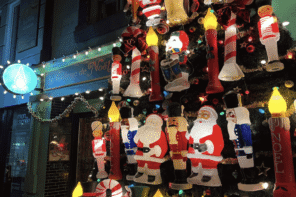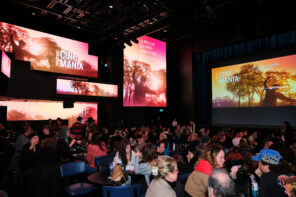An art form with a rich history, burlesque showcases the eroticism of the individual. Burlesque is often a mix of humour and dance, meant to entertain as well as titillate. With its roots in 17th century comedic poetry, theatrical burlesque started gaining popularity as a form of 19th century Victorian entertainment. Out of this, an American burlesque style evolved in the 1900s, fuelling the cultural creation of archetypes like the flapper and the pin-up girl. More than just a striptease, burlesque focuses on bringing out an emotional response from sensual and humorous song and dance.
A modern burlesque performance typically plays out as a variety show, infused with irreverence and eroticism. From dancing and singing to comedy and erotic striptease, a burlesque show can have a little bit of everything. Generally, performers want to exhibit their burlesque “persona” in the way they find most empowering and, ultimately, sexy. Far from the stuffy, separated stance traditional theatre has toward audience participation, a burlesque show thrives on connectivity and interaction between performer and viewer.
Seductive Origins: The History of Burlesque in Montréal
In Montréal, the burlesque scene began gaining popularity during the mid-twentieth century. With performers travelling to Canada from places like New York City, Montreal’s burlesque was established as a distilled mixture of vaudeville and cabaret themes into a fun, entertaining nightlife. Today, Montréal boasts a thriving burlesque scene. The city’s Burlesque Festival has occurred annually since 2009. The event’s goal is to revive and celebrate the romantic and seductive art of burlesque that many feel has been lost in today’s society.
Although burlesque toutes self-expression as a major value, the Montréal burlesque scene has lacked diversity for years. Mostly involving straight, conventionally attractive performers, the burlesque scene in Montréal has alienated a significant number of performers who are interested in partaking in the fun and liberating culture of burlesque, but do not conform to the mainstream style Montréal’s scene has taken on.
Baring It All: LatinX Performers On Display During Fierté 2020
Performers Salty Margarita and Black Mamba founded LatinX Burlesque Canada in 2014 to address this lack of on-stage diversity in Montréal’s burlesque scene. Not only is this the only troupe in the country to exclusively feature Latino and Hispanic performers, but it also spotlights 2SLGBTQIA+ dancers and men.
“It starts with body shape,” explained producer Salty Margarita. “We are more curvy. Secondly, when we try to include guys in the show. The first thing that we shared was, “Who’s going to want to see Latino men?” Latino men want to see sexy women. [However,] Gay men in [the] Latino community [have existed since a] long time ago.”
The Orgullo LatinX 2020 performance took place as a matinee performance on Saturday, August 15th at a theatrical venue on St. Catherine Street. The dancers performed in front of a small, live audience, all of whom wore masks. However, the entire performance was recorded live and posted publicly on YouTube, allowing viewers from across Canada to tune in to the sultry, French-Canadian fun.
Salty Margarita shared both the benefits and challenges of putting on a socially-distanced show. “Pride was very supportive in the sense that we respected all the health measures with rules, masks. We ran the whole show on stage…respecting social distancing. [But] we would love to go back to live-stage. This is our first show that we [performed] virtual. We got exhausted.”
I’m a tropical bird, so I need to shine like a tropical bird..
The one-hour production included nine different burlesque performers, each with their own unique, three-minute routine. Miami Minx (@themiamiminx) used a purple, peacock feather fan to titillate the audience during a sexy, shadowy number. Later, Cherry Topp (@thecherrytopp) stripped from a fuzzy red bathrobe down to nothing but a small pouch covering his genitals, only to then lie horizontally on two chairs and spray himself in whipped cream.
Each performance made use of colourful, layered costumes and dancing styles to match the mood of the music. Co-founder Black Mamba (@blackmambaburlesque) channelled her innner femme fatale to Jennifer Lopez’s “Dinero,” while El Toro (@eltoroboylesque) used Marc Antony’s “Via la Vida” to show his sexiest inner matador. The group’s producer shared how audience members overlook how much craft, care, and dedication is involved in creating a burlesque routine.
“Sofia Vergara. I give all my respect to her, but we are not her…
“In the three minutes, you have to build a story, a character. In addition, it is a theatrical form. You need to start with a story in three or four minutes…” She especially emphasized the importance of creating a convincing costume. “I’m a tropical bird, so I need to shine like a tropical bird…you need to have a certain kind of creativity and artistic creation to be like, ‘I want my dress to look like that!’”
Salty Margarita went on to insist how all body types are welcome in the burlesque community, not just those who are traditionally attractive. “Sofia Vergara. I give all my respect to her, but we are not her… Because it’s not about showing off body parts. It’s about accepting yourself as you are. Because not all of us go to the gym every day.”
While the LatinX Burlesque Canada producer expressed respect and admiration for strippers, she argued how burlesque is closer in practice to theatre than stripping. “My point with burlesque is that it’s a theatrical form and it should be highlighted as a theatrical form, as a form of art.”
After The Show: Supporting The Burlesque Scene Year-Round
As our interview came to a close, Salty Margarita took a moment to underscore the political importance of burlesque for the Latin American community. At a time in which gay people face more hate crimes in Latin America than they do in Europe, the Middle East, or Africa — and in which transgender people risk employment discrimination and shockingly high murder rates — burlesque provides Latin Americans with the rare opportunity to openly express and embrace their sexuality.
“In Latin America, there are still a lot of stereotypes and misconceptions about men and women: that women are sexy and beautiful, basically they are good mothers and housewives and that men are very modest. That’s not true!”
Salty Margarita had to leave early for a phone interview; no doubt she was booking another virtual gig after the spectacular August 15th performance. Yet, she encourages McGill students to explore the burlesque community of Montréal in their free time. As gay bars across the city slowly (and safely) begin to reopen, now is the time to support the burlesque groups in the city that have been struggling for months.
“Share information. Share our shows. Click on the link and share it with your friends. With your relatives. With [everyone] that is close to you…Share the word. That’s the most important thing. We are here.”








